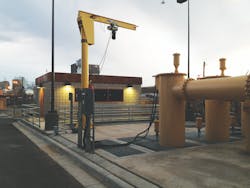Asad Choudry is business development manager for Xylem. Choudry can be reached at [email protected].
After a summer monsoon devastated the city of El Paso, Texas, in 2006, the community needed help. El Paso lies on the tip of the Chihuahuan Desert. It is not uncommon for a year’s worth of rain to occur in a matter of days during the summer. These rain events have caused serious damage throughout the city for years, and the flooding always has been particularly bad in the Chihuahuita historic district. A storm water pumping station with Xylem’s Flygt pumps has helped solve this problem.
When El Paso received a year’s worth of rain in just two days, the city endured more than $200 million in damages to businesses and homes and $115 million in damages to the city’s storm water system. In response, the El Paso City Council formed a storm water utility to address the flooding issues. It hired an engineering firm, CEA Group, to conduct a drainage study with the goal to reduce the impact of these storm events. CEA Group determined that the flooding in El Paso was directly linked to high water levels in the Rio Grande River during heavy rains.
“The Chihuahuita neighborhood comprises roughly about 12 acres of residential housing and small businesses, and is the only access road to the Canal Surface Water Treatment Plant (CWTP)," said Warren Marquette, water utility engineer for the city of El Paso. “The area is low, bounded on all sides by railroad lines and the water treatment plant. The ground elevation is roughly equivalent to the high water surface of the river.”
Storm sewer inlets that were added in the past in an attempt to drain the area were connected to a system that drained the watershed at a higher elevation. This caused runoff from upstream storms to create a backup in the drainage system, flooding the Chihuahuita neighborhood.
Limited Space
A new pump station was determined to be the best solution to control the river water level and subsequently prevent the flooding. However, the solution would be difficult, because the neighborhood did not have the footprint or the funding for a conventional storm water pumping station.
The storm water utility required the pump station to function while the river is low-or at normal level-and while the river is at the flood stage. The design would need to overcome these restrictions by utilizing a siphon when the river is low and the full pump horsepower while the river is at its normal level.
In 2012, a representative from Flygt distributor James, Cooke and Hobson Inc. (JCH) contacted Flygt for assistance. With input from CEA Group, JCH and Flygt engineers, a pump station design was developed that could function properly even when the space requirements were less than the recommended Hydraulic Institute standards for high-volume pump stations.
Pumping Requirements
The project required the design of a pump station that would be able to efficiently transport the storm water and utilize the smallest footprint possible, ultimately resulting in lower civil costs for the city.
“The available forebay on this site is only about 20-ft long-far short of the minimum for forebay conventional design outlined by the Hydraulic Institute,” Marquette said. “Two 30-ft-by-80-ft lots were acquired to allow for piping and for the new station footprint. Emergency backup power was installed on the CWTP property adjacent to the station.”
The Flygt axial flow propeller pumps PL7061 were selected due to their high efficiency and low power consumption. The design also utilized Flygt’s Formed Suction Intake (FSI) installed under the propeller pump ensuring optimal inlet hydraulic conditions. In addition, this configuration allowed a more constant pumping condition regardless of the river level.
The Flygt FSI is an inlet device that provides optimal inflow to the axial flow propeller pump by gradually accelerating and redirecting the flow toward the pump inlet. Its primary function is to condition the incoming flow into a uniform profile and redirect the flow. The Flygt FSI compact design is ideal for use when available space is limited.
“Directing the incoming flow to the pump impeller eye significantly reduced the required submergence and potential for vortex air entrainment, and reduced the size of the forebay,” Marquette said.
By providing a reliable pump intake in limited space, the Flygt FSI achieved a more economical pump station solution with a smaller footprint and better hydraulic performance.
Performance
With a pumping capacity of 27,000 gal per minute, the station can handle 100-year storm events. By utilizing siphoning methods, the city could accommodate the large swing in river elevations, allowing the station to operate at high and low river levels.
The pump station project included storm drain improvements and the relocation of numerous existing water and sewer lines that serve the downtown area.
When torrential rains hit the Chihuahuita historic district of El Paso again in 2012, the results were different. With the new storm water pumping station in place and functioning well, flooding was not an issue, bringing much-needed relief to the historic area.
“Since the station has been installed and the routes of backflow have been eliminated, the station neighborhood has not experienced any further flooding,” Marquette confirmed.






